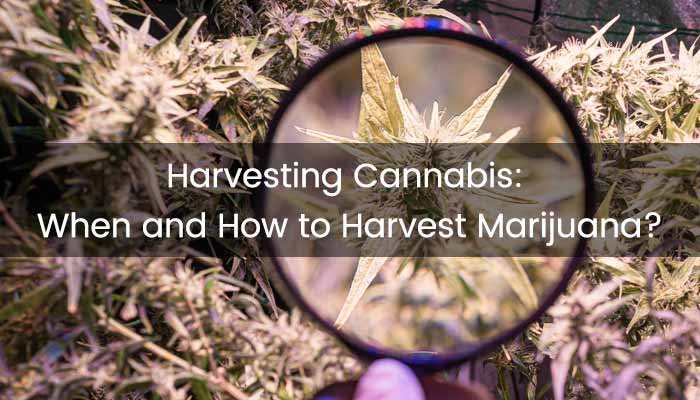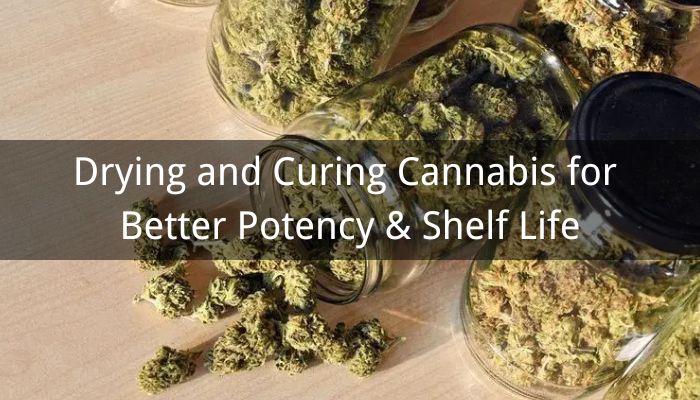In general, when most of the cannabis trichomes are creamy or cloudy, it's time to harvest cannabis as the THC content is at its peak. When some of the trichomes turn amber, the THC begins to convert to CBN, resulting in a more soothing effect. For outdoor growers, the best time to harvest is typically late September to early October.
After giving your cannabis plants all the care and effort, it's finally time to harvest cannabis. But when and how do you harvest marijuana? These questions will greatly impact your plants' quality, potency, and smell.
In this article, we'll guide you through the best time for harvesting cannabis and provide tips on how to harvest marijuana. We hope this helps you achieve the highest THC levels, potency, and smell after harvesting cannabis.
Table of Contents:
Why Does the Timing of Cannabis Harvest Matter
Learning when to harvest cannabis is crucial for optimizing the quality and potency of the final buds. Harvesting cannabis at the optimal moment ensures peak THC levels and a balanced cannabinoid profile, which affects the desired psychoactive or medicinal effects.
Additionally, the terpene profile in weed, responsible for the plant's aroma and flavor, is best preserved when harvested at the right time, enhancing the overall sensory experience.
However, incorrect timing for harvesting cannabis can lead to lower potency, reduced yield, and less flavorful buds. By carefully monitoring trichome and pistil color, as well as the plant’s overall health, growers can harvest marijuana with the best THC and aroma.

Trichome color chart
How to Know When to Harvest Cannabis
There are 3 main methods for determining when to harvest marijuana, observing trichome color, pistil color, and leaf condition. Here are some details.
Trichome Color
Trichomes, the tiny resin glands on cannabis buds, change color as the plant matures, and it is the time for cannabis harvest. Clear trichomes indicate the plant is not ready, as THC has not fully developed.
The optimal time to harvest cannabis is when approximately 70-90% of the trichomes have turned milky or cloudy. This stage indicates that the THC content is at its peak, providing the most potent psychoactive effects.
For harvesting a more balanced or slightly sedative effect cannabis, you might wait until some trichomes (around 30-50%) turn amber, but the majority should still be milky for the best overall quality.
This is because when trichomes turn milky or cloudy, THC is at its peak. On the other hand, amber trichomes signify THC is degrading into CBN, resulting in a more sedative effect, suitable for those seeking a relaxing experience.

Pictures of Trichomes Ready for Harvest
Pistil Color
Pistils, the hair-like structures on buds, also change color as the plant matures. White pistils indicate that the buds are still developing and not yet ready for cannabis harvest.
When about 70-80% of the pistils turn brown or red, it typically signals that the plant is ready to be harvested. This visual cue helps growers determine the optimal harvest time for potent and flavorful buds.
Leaf Condition
As the marijuana nears maturity, the larger fan leaves will begin to yellow and die off before harvesting the cannabis. This natural process indicates that the plant is redirecting its energy to the buds. Yellowing leaves are a good sign that harvest time is approaching.
These are the three general guidelines for determining when to harvest weed. Following these guidelines will help you harvest cannabis with optimal THC levels, flavor, and aroma. Additionally, I have 5 tips and notes below that I hope you will find helpful.

Pictures of buds ready for harvest
When to Harvest Marijuana: 5 Tips & Notes
We've learned when to harvest marijuana, but plans often can't keep up with changes. Being well-prepared can help you successfully harvest cannabis. Here are five tips and notes for determining the best time to harvest cannabis.
5 Tips for Harvesting Cannabis
Tips for harvesting cannabis include avoiding harvesting too early or too late, staggered harvesting, and understanding strain differences. Here are the details.
Avoid Early Harvesting: Excited new growers often harvest cannabis too early. What happens if I harvest my buds too early? It may lead to lower yields and reduced potency. If you're unsure whether your buds are ready, cut the most mature-looking buds, dry them, and test their potency.
Staggered Harvesting: Harvest small cannabis batches of buds gradually to observe their maturity and potency, while allowing the remaining buds to continue maturing. This helps identify the best harvest cannabis time and reduces the temptation to harvest too early.
Observe Pistils and Trichomes: Wait for the cannabis pistils to darken and curl before harvesting the cannabis. Use a magnifying glass to check the trichome color. When most trichomes are milky white, THC content is at its peak. If some trichomes turn amber, the effect will be more relaxing.
Understand Strain Differences: Different strains have varying trichome color change rules during cannabis harvest seasons. For example, some sativa and haze strains never turn amber. Look up our specific strain guides for detailed information.
Avoid Late Harvesting: Harvesting cannabis too early may reduce potency, but what happens if you wait too long to harvest buds? Harvesting too late when trichomes turn gray or wither will weaken the buds' effects. Typically, buds need to wait 2-4 weeks before losing potency.
To achieve the highest THC content and optimal psychoactive effects, harvest cannabis when most trichomes are milky white. By following these tips, you can harvest your cannabis at the perfect time, ensuring the best potency and effect.
When Not to Harvest Cannabis?
Avoid harvesting cannabis too early in the flowering stage, when trichomes are still clear and pistils are predominantly white. Harvesting prematurely results in underdeveloped, low-density, and less potent buds.
Additionally, do not harvest cannabis during stressful conditions such as extreme temperatures, pest infestations, or nutrient deficiencies, and avoid harvesting immediately after applying pesticides or nutrients. Residues need time to break down or be flushed from the plant to ensure a clean and safe bud.
When Not to Harvest Cannabis: Trichomes are still clear.

How to Harvest Cannabis
Harvesting cannabis requires choosing the right time of day, picking early in the morning or before the houseplant lights come on. Terpene levels are highest at this time, ensuring maximum flavor and aroma. There are also 3 key steps to help you get the highest THC and flavor when harvesting cannabis, let’s check them out.
Tools Preparation
Gather sharp pruning shears or scissors, gloves, a clean workspace, a grow tent kit and containers for harvesting cannabis and collecting the trimmed buds. Disinfect your tools to prevent contamination.
Harvesting cannabis
When harvesting cannabis, you can either cut the entire column of cannabis and slice the entire plant off at the base, a harvesting method that is suitable for smaller cannabis and allows for even drying, or slice off individual branches by cutting down near the main branch stem, a method that is suitable for larger plants and more controlled drying conditions.
Trimming the buds
When trimming cannabis, there are two methods: wet trimming, done immediately after harvest to reduce the risk of mold; and dry trimming, involving hanging branches to dry before trimming. Dry trimming enhances flavor and aroma but takes more time to harvest cannabis, and is suitable for growers seeking higher THC content.
Drying and Storage
Once harvested weed, hang pruned cannabis branches upside down in a dark, well-ventilated room and keep the temperature at 60-70°F (15-21°C) and the humidity at 50-60%. Dry for 7-14 days until the branches can be broken rather than bent.
After drying, place dried buds in an airtight glass jar and store them in a cool, dark place. Open the jar daily for the first week to release moisture for at least 2-4 weeks, which will also better enhance flavor and potency.
By following these steps, you can successfully harvest, trim, dry, and store your weed. Moreover, if you want to harvest a portion of your cannabis plant instead of the whole plant to avoid the risk of harvesting cannabis too early or too late, you can follow the advice below.

How to Harvest Half a Cannabis Plant
Harvesting the top half of a cannabis plant can increase yield and potency. Removing the top buds that mature faster due to nearest the cannabis grow light, allows more light to reach the lower buds, helping them to mature faster and improve their potency.
Start by preparing your tools and workspace, ensuring everything is clean and disinfected. Identify the mature buds with milky or cloudy trichomes and brown or red pistils, typically found at the top of the plant. Carefully cut these buds using sharp pruning shears, leaving the lower, less mature buds intact.
Once harvested cannabis, trim the buds and dry them in a dark, well-ventilated room with controlled temperature and humidity. Continue to care for the remaining plant, monitoring the lower buds for optimal cannabis harvest time. When ready, harvest the remaining buds using the same techniques. This approach can improve the overall quality and potency of your cannabis harvest.
Conclusion
In conclusion, you can ensure that your cannabis harvest is at its best in terms of THC content, potency, and flavor by following our tips on when and how to harvest cannabis.
If you would like more detailed information on cannabis harvesting and cultivation, such as choosing full-spectrum grow lights, please visit our website or subscribe to our newsletter. Happy growing, and may your harvests be bountiful and potent!
Related Post:
What Is the Optimal PPFD for Cannabis
Improving Cannabis Potency Guide
Cannabis Flowering Stage Guide
FAQ about When to Harvest Cannabis
1. What Should My Cannabis Plant Look Like Before Harvest?
When your cannabis plant trichomes will appear mostly cloudy or milky and the pistils change from white to reddish-brown, it's the best time to harvest cannabis. If you prefer a more relaxing effect, wait until 20-30% of the trichomes are amber.
2. Can I Harvest Cannabis with White Hairs?
When harvesting cannabis plants, the most important thing is to know when to harvest. White pistils indicate that the plant is still in the flowering stage and hasn't fully matured. The buds are still developing, and the trichomes likely haven't reached their peak potency.
3. Can I Harvest the Top Half of My Plant?
Yes, you can harvest the top half of your cannabis plant as the top buds mature faster due to better light exposure. By harvesting the top, you allow more light to reach the lower buds, giving them time to develop fully and improve in quality.
4. When to Stop Watering Before Harvest Weed?
It's best to stop watering one to two weeks before harvesting cannabis. This allows cannabis plants to use up remaining water and nutrients, enhancing the flavor and potency of the buds. This method also promotes resin production, improving terpene development and the overall aroma.
5. What Happens if You Don't Flush Cannabis Before Harvest?
Flushing before harvesting cannabis allows the plant to use up stored nutrients, improving the flavor and aroma of the buds. If you don't flush cannabis before harvest, the plants may retain excess nutrients, leading to a harsh taste and smell when smoked.
6. Should You Leave Cannabis Plants in the Dark Before Harvest?
Yes, leaving cannabis plants in the dark before harvest is a common practice that can benefit the final buds. The method is to give the plants a dark period of 24 to 48 hours before harvesting cannabis which is to help increase resin production and enhance overall potency.




